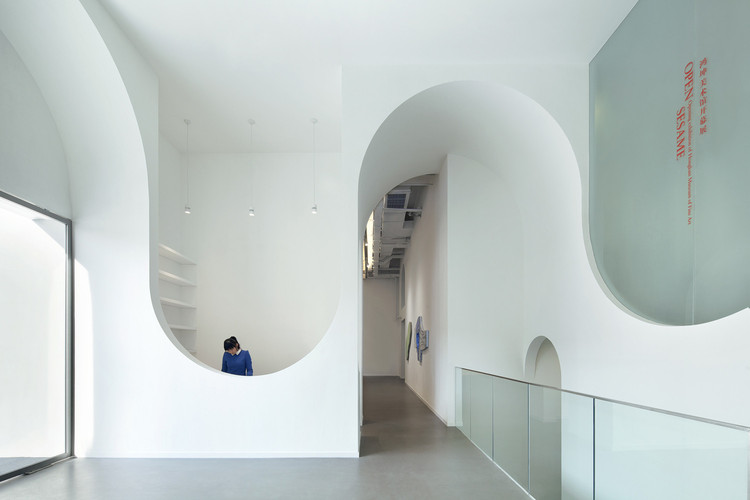
Lyon Part-Dieu Urban Shopping Center / MVRDV
Radio Hotel and Tower / MVRDV
Valley Towers / MVRDV

-
Architects: MVRDV
- Area: 75000 m²
- Year: 2022
-
Professionals: G&S Bouw B.V., Boele & Van Eesteren B.V., DeltaVorm Groep & Piet Oudolf, Heyligers Architects, Inbo, +5
Church to Apartments Transformation / HOYT Architecten

-
Architects: HOYT Architecten
- Year: 2022
-
Professionals: Van Wijnen Stolwijk, CAE Delft
Sluishuis Residential Building / BIG + Barcode Architects

-
Architects: Barcode Architects, Bjarke Ingels Group
- Area: 49000 m²
- Year: 2022
Amare Home of the Performance Arts / NOAHH
The Comeback of Curved Design: Materials That Can Bend and Curl

Take a second to imagine a building or a room. Chances are you are envisioning flat rectangular surfaces and straight lines. Whether it be walls, beams or windows, most architectural elements come in standard and extremely practical orthogonal shapes. However, the pandemic has shed light on designs that are not only functional, but also that improve our mood and well-being. In that sense, the power of curved, free-flowing surfaces is unmatched, which explains why they have been making a comeback as a modern design trend. Adopting beautiful nature-inspired shapes, organic curls and bends energize rooms and make users feel good. In fact, neuroscientists have shown that this affection is hard-wired into the brain; in a 2013 study, they found that participants were most likely to consider a space beautiful if it was curvilinear instead of rectilinear. In short, humans love curves.
The Rise of Co-Living: Designing for Communal Life

Communal living is nothing new. Throughout history, housing has long been tied to both shared needs and a concentration of resources. Today, between population growth and an increase in urban density and real estate prices, architects and urban planners have been pursuing alternatives for shared living. These new models explore a range of spatial and formal configurations with a shared vision for the future.
The Potential of Bamboo and Mass Timber for the Construction Industry: An Interview with Pablo van der Lugt

Pablo van der Lugt is an architect, author and speaker. His research focuses on the potential of materials such as bamboo and mass timber for the construction sector, and their positive impacts on the world. “Throughout my professional career both in university (including my PhD research on the carbon footprint of engineered bamboo and wood) and industry the past 15 years I have found there are many misconceptions about these materials which hamper their large scale adoption. For this reason I ‘translated’ my research findings into two contemporary books for designers and architects about the potential of bamboo: Booming Bamboo, and engineered timber: Tomorrow’s Timber. They aim to dispel these myths and show the incredible potential of the latest generation of biobased building materials in the required transition to a carbon neutral, healthy and circular built environment.” We recently had the opportunity to talk with him about these topics. Read more below.
Lycka Amsterdam Apartments / Team Paul de Vroom + Sputnik

-
Architects: Team Paul de Vroom + Sputnik
- Area: 10000 m²
- Year: 2021
Ilot Queyries Apartment Building / MVRDV

-
Architects: MVRDV
- Area: 23000 m²
- Year: 2021
-
Manufacturers: AGROB BUCHTAL
House Buiksloterham / NEXT architects

-
Architects: NEXT architects
- Area: 260 m²
- Year: 2017
-
Professionals: Bouwbedrijf J. NAT en ZN
National Monument Kamp Amersfoort / Inbo BV

-
Architects: Inbo BV
- Area: 1126 m²
- Year: 2021
-
Professionals: Salverda bouw, Deerns
Pontsteiger Residential Building / Eden District

-
Architects: Arons & Gelauff architecten
- Area: 64000 m²
- Year: 2019
-
Manufacturers: Feldhaus Klinker, Hibex, Koninklijke Tichelaar
Construction and Design Trends of 2021: The Recurring, The Popular, The Relevant and The Substantial

As we look back at the architecture projects we have published in 2020, as part of our yearly review, we were able to distinguish many recurring elements and solutions in terms of materials, programs, and functions.
Since the architecture industry moves slightly slower than others, we found that many things in the construction and design that have been building up these past years have come out making strong statements this 2020. We believe, therefore, that trends in the architecture world could be defined not only by what has been recurrent and popular but also, what has proven to be relevant and substantial.
















































































_B.jpg?1608618979&format=webp&width=640&height=580)